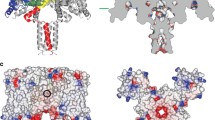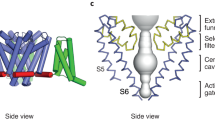Summary
Two domains of Na channels were mapped with site-specific antibodies raised in rabbit against synthetic peptides corresponding to a part of the voltage sensor of internal repeat 1C +1 (amino acids 210–223) and to a region designated dipole (amino acids 1690–1699) of eel electroplax sodium channels. The antibodies bind to their respective domains in both purified and membrane-bound channels and immunoprecipitate the channels from eel electroplax and rat brain synaptosomes.
Anti-C +1 depresses the action potential of rat sciatic nerve in a concentration-dependent way. It binds to the external side of rat brain synaptosomal vesicle, and its binding is potentiated by depolarization. Anti-dipole binds to the inner side of the vesicle, and the binding is inhibited by depolarization.
Similar content being viewed by others
References
Agnew, W.S., Rosenberg, R.L., Tomiko, S.A. 1986. Reconstitution of the sodium channels from Electrophorus electricus. In: Ion Channel Reconstitution. C. Miller, editor. pp. 307–336. Plenum, New York
Aldrich, R.W., Stevens, C.F. 1987. Voltage dependent gating of sodium channels from mammalian neuroblastoma cells. J. Neurosci. 7:418–431
Armstrong, C.M. 1981. Sodium currents and gating currents. Physiol. Rev. 61:644–683
Barchi, R.L. 1988. Probing the molecular structure of the voltage dependent sodium channel. Annu. Rev. Neurosci. 11:455–495
Barzilai, A., Rahamimoff, H. 1987. Stoichiometry of sodium-calcium exchanges in nerve terminals. Biochemistiy 26:6113–6118
Bezanilla, F. 1985. Gating of sodium and potassium channels. J. Membrane Biol. 88:97–111
Bruns, R.F., Lawson-Wendung, K., Pugsley, T.A. 1983. A rapid filtration assay for soluble receptors using polyethylen amine-treated filters. Anal. Biochem. 132:74–81
Caldwell, J.H., Schaller, K.L. 1989. Isolation of novel Na channel genes by PCR gene amplification. Soc. Neurosci. 15:197a
Catterall, W.A. 1988. Structure and function of voltage sensitiveion channels. Science 242:50–61
Catterall, W.A. 1990. Molecular properties of voltage sensitive Na+ and Ca++ channels. Biophys. J. 57:195a
Costa, M.R., Catterall, W.A. 1984. Cyclic AMP-dependent phosphorylation of the alpha subunit of the sodium channel in synaptic nerve ending particles. J. Biol. Chem. 259:8210–8218
Duch, D.S., Levinson, S.R. 1987. Neurotoxin modulated uptake of sodium by highly purified preparation of the electroplax tetrodotoxin binding glycoprotein reconstituted into lipid vesicles. J. Membrane Biol. 98:43–55
Ganetzki, B., Loughney, K. 1989. Alternative splicing generates distinct sodium channel subtypes in Drosophila. Soc. Neurosci. 15:196a
Gasko, D.D., Knowles, A.F., Shertzer, H.C., Suolinna, E.H., Racker, E. 1976. The use of ion exchange resins for studying ion channel transport in biological systems. Anal. Biochem. 72:57–65
Gordon, R.D., Fieles, W.E., Schotland, D.L., Hogue-Angeletti, R., Barchi, R.L. 1987. Topographical localization of the C-terminal of the voltage-dependent sodium channel from Electrophorus electricus using antibodies raised against a synthetic peptide. Proc. Natl. Acad. Sci. USA 84:308–312
Gordon, R.D., Li, Y., Fieles, W.E., Schotland, D.L., Barchi, R.L. 1988. Topological localization of a segment of the eel voltage dependent sodium channel primary sequence (AA927–938) that discriminates models of tertiary structure. J. Neurosci. 8:3742–3749
Greenblatt, R.E., Blatt, Y., Montal, M. 1985. The structure of the voltage sensitive sodium channels. Inferences derived from computer-aided analysis of the Electrophorus electricus channel primary structure. FEBS Lett. 193:125–134
Guy, H.R. 1987. How sodium channels work—a molecular model. Curr. Topics Membr. Transp. 33:289–308
Guy, H.R., Conti, F. 1990. Pursuing the structure and function of voltage-gated channels. Trends Neurosci. 13:201–206
Guy, H.R., Seetharamulu, P. 1986. Molecular model of the action potential sodium channel. P roc. Natl. Acad. Sci. USA 83:508–512
Hille, B. 1984. Ionic Channels of Excitable Membrane. pp. 426. Sinauer, Sunderland (MA)
Hodgkin, A.L., Huxley, A.F. 1952. A quantitative description of membrane current and its application to conduction and excitation in nerve. J. Physiol. 116:500–544
Kallen, R.G., Sheng, Z., Yank, J., Chen, L.Q., Fishbeck, K., Barchi, R.L. 1990. Primary structure and expression of a sodium channel characteristic of denervated and immature rat skeletal muscle. Neuron 4:233–242
Kanner, B.I. 1980. Modulation of neurotransmitter transport by the activity of the action potential sodium ion in membrane vesicles from rat. Biochemistry 19:692–697
Kayano, T., Noda, M., Flockerzi, V., Takahashi, A., Numa, S. 1988. Primary structure of the rat brain sodium channel III deduced from the cDNA sequence. FEBS Lett. 228:187–194
Kosower, E.M. 1985. A structural and dynamic molecular model for the sodium channel of Electrophorus electricus. FEBS Lett. 182:235–242
Kosower, E.M. 1991. Structure and dynamic molecular models for sodium channels. In: The Molecular Basis of Learning and Memory. Princeton University Press (in press)
Laemmli, U.K. 1970. Cleavage of structural proteins during the assembly of the head of bacteriophage T4. Nature 227:680–685
Levinson, S.R., Duch, S.D., Urban, B.W., Recio-Pinto, E. 1986. The sodium channels from Electrophorus electricus. Ann. NY Acad. Sci. 479:162–178
Lombet, A., Lazdunski, M. 1984. Characterization, solubilization, affinity labeling and purification of the cardiac sodium channel using Tityus toxin gamma. Eur. J. Biochem. 141:651–660
Lowry, O.H., Rosenbrough, N.J., Farr, R.J., Randall, J. 1951. Protein measurement with the folin-phenol reagent. J. Biol. Chem. 193:265–275
Meiri, H., Sammar, M., Schwartz, A. 1989. Production and use of synthetic peptide antibodies to map a region associated with sodium channel inactivation. Immunological techniques: Anti-idiotype antibodies and molecular mimicry. Methods Enzymol. 178:714–739
Meiri, H., Spira, G., Sammar, M., Namir, M., Schwartz, A., Komoriya, A., Kosower, E.M., Palti, Y. 1987. Mapping a region associated with Na channel inactivation using antibodies to a synthetic peptide corresponding to a part of the channel. Proc. Natl. Acad. Sci. USA 84:5058–5062
Merrifield, R.B. 1985. Solid phase synthesis. Angew. Chem. Int. Ed. Engl. 24:799–810
Miller, C.M. 1986. How ion channel proteins work. In: Neuro-modulation: The Biochemical Control of Neuronal Excitability. L.K. Kaczmarek and I.B. Levitan, editor. Chap. 3, pp. 39–55. Oxford University Press, New York
Noda, M., Idada, T., Suzuki, H., Takeshima, H., Takahashi, T., Kuno, M., Numa, S. 1986a. Expression of functional sodium channels from cloned cDNA. Nature 322:826–828
Noda, M., Ikeda, T., Kayano, T., Suzuki, H., Takeshima, H., Kurasaki, M., Takahashi, H., Numa, S. 1986b. Existence of distinct sodium channel messenger RNA in rat brain. Nature 320:188–192
Noda, M., Shimizu, S., Tanabe, T., Takai, T., Kayano, T., Ikeda, T., Takahashi, H., Nakayama, H., Kanaoka, Y., Miniamino, N., Kangawa, K., Matsuo, H., Raftery, M.A., Hirose, T., Inayama, S., Hayashida, H., Miyata, T., Numa, S. 1984. Primary structure of Electrophorus electricus sodium channel deduced from cDNA sequence. Nature 312:121–127
Pusch, M. 1990. Block of different cloned Na-channels by internal Mg++ and external Ca++. Biophys. J. 57:105a
Reeves, S., Sutko, J.L. 1979. Na-Ca ion exchange in cardiac membrane vesicles. Biochemistry 76:590–594
Rogart, R.B., Cribbs, L.L., Muglia, L.K., Kephalp, D.D., Kaiser, M.W. 1989. Molecular cloning of a putative TTX-resistant rat heart Na channel isoform. Proc. Natl. Acad. Sci. USA 86:8170–8174
Rossie, S., Gordon, D., Catterall, W.A. 1987. Identification of an intracellular domain of the sodium channel having multiple cAMP-dependent phosphorylation sites. J. Biol. Chem. 262:17530–17539
Salkoff, L., Butler, A., Wei, A., Scavarda, N., Baker, K., Pauron, D., Smith, C. 1987. Trends Neurosci. 10:522–527
Salkoff, L., Butler, A., Wei, A., Scavarda, N., Giffen, K., Ilfune, C., Goodman, R., Mandel, G. 1987. Genomic organization and deduced amino acids sequence of a putative sodium channel gene in Drosophila. Science 237:744–748
Schwartz, A., Palti, Y., Meiri, H. 1990. Structural and developmental differences between 3 types of Na channels in dorsal root ganglion of newborn rats. J. Membrane Biol. 116:117–128
Stuhmer, W. 1990. Site directed mutagenesis on voltage gated channels. Biophys. J. 57:386a
Stuhmer, W., Conti, F., Suzuki, H., Wang, X., Noda, M., Yahagi, N., Kubo, H., Numa, S. 1989. Structural parts involved in activation and inactivation of the sodium channel. Nature 339:597–603
Suzuki, H., Beckh, S., Kubo, H., Yahagi, N., Ishida, H., Kayano, T., Noda, M., Numa, S. 1988. Functional expression of cloned cDNA encoding sodium channel III. FEBS Lett. 228:195–200
Tosteson, M.T., Auld, D.S., Tosteson, D.C. 1989. Voltage gated channels formed in lipid bilayers by a positively charged segment of the Na-channel polypeptide. Proc. Natl. Acad. Sci. USA 86:707–710
Trimmer, S., Jr., Cooperman, S.S., Tomiko, S.A., Zhou, J., Crean, S.M., Boyk, M.B., Galle, R.G., Sheng, Z., Barchi, R.L., Sigworth, F.J., Goodman, R.H., Agnew, W.S., Mandel, G. 1989. Primary structure and functional expression of a mammalian skeletal muscle sodium channel. Neuron 3:33–49
Vassilev, P.M., Scheur, T., Catterall, W.A. 1988. Identification of an intracellular peptide segment involved in sodium channel inactivation. Science 241:1658–1660
Wray, W., Boulikas, T., Wray, V.P., Hancock, R. 1981. Silver staining of proteins in polyacrylamid gels. Anal. Biochem. 118:197–203
Author information
Authors and Affiliations
Additional information
We are most grateful to Dr. M.T. Tosteson (Harvard Medical School) for providing us with samples of the S4IV peptides. We wish to express our gratitude to Drs. D. Gordon (Hebrew University) and A. Safran (The Weizmann Institute) for helping in the immunoprecipitation procedure, to Drs. H. Rahamimoff (Hebrew University) and A. Barzilai (Columbia University) for advising us with the vesicle experiments, to Drs. D. Kassel and M. Gavish (Technion) for many fruitful discussions, and to Dr. Y. Palti (Technion) for discussions of electric field and suggesting the dipole peptide. This work was supported by a basic research fund (BRF) of The Israel Academy of Sciences #430.87 (H.M. and G.S.), a BSF Grant #84-00367 (H.M.) and The Henry Gutwirt Fund for the Promotion of Research-Technion VPR Fund #184-0093 (H.M.).
Rights and permissions
About this article
Cite this article
Sammar, M., Spira, G. & Meiri, H. Depolarization exposes the voltage sensor of the sodium channels to the extracellular region. J. Membarin Biol. 125, 1–11 (1992). https://doi.org/10.1007/BF00235793
Received:
Revised:
Issue Date:
DOI: https://doi.org/10.1007/BF00235793




